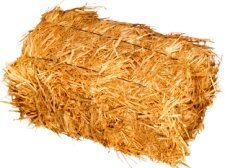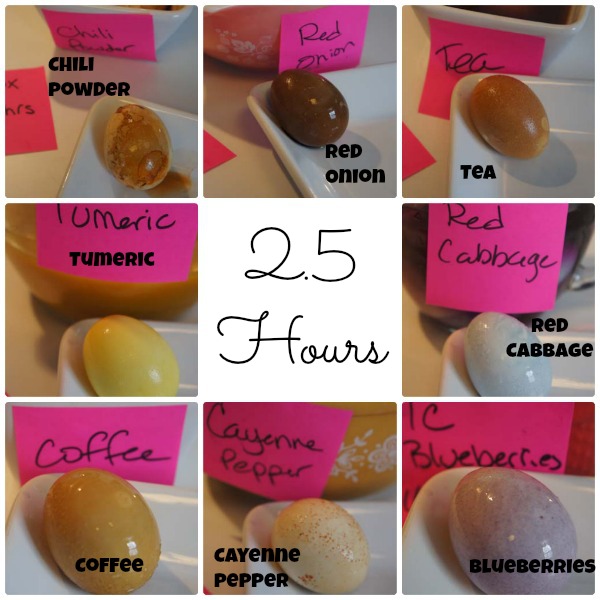This is the way Tom plans to plant at least a few hills of corn, beans and squash. He calls them the "Three Amigos," but it is the same Native American technique for planting.
This tip come from The Book of Three Web Site.
I am learning to live a leaner, cleaner and greener lifestyle. This blog is to share what I have learned and hope I find friends along that way to join me in this life changing path.
About Me
- Donna H - LCG Queen
- Former teacher, clinical social worker and now entrepreneur. My focus, no matter what career I am engaged in, has been on helping people. Now I am on an incredible journey to change life in a leaner, cleaner, greener way. I hope you will join me in this transition.
Thursday, March 28, 2013
Garden in a Bale of Straw
Limited space? No soil? Toxic or rocky ground? Spare corner? Edge of drive way or yard? Here's bales of advice for you on the straw bale gardening.
Straw bale, or hay bale gardening is not to be confused with using loose straw in your garden for mulch or compost. What we're talking about here is the whole bale, as it stands, tied with twine and used for planting plants on the top.
The bale is the garden. Put it on your balcony or path if you want to. Use one or umpteen bales of straw or hay as you need and in any pattern. Because the straw bale garden is raised, it's easy to work with, so make sure you allow for handy access.
Which straw to use for straw bale gardening? The best straw bales, for a garden are wheat, oats, rye or barley straw. These consist of stalks left from harvesting grain, they have been through a combine harvester and had the seeds threshed from them, leaving none or very few left.
Hay bales for gardening are less popular as they have the whole stalk and seed heads with many seeds. They also often have other weeds and grass seeds to cause trouble. Use what you can get locally--it may even be lucerne, pea straw, vetch or alfalfa bales. Corn and linseed (flax) bales are not so good as they are very coarse, and linseed straw take a long time to decompose due to the oil residue left on the stalks.
It's simple to pull out the odd wayward grain seeds with straw bale gardening, but hay hales have a tendency to grow the likes of a small lawn! Thus you may need to occasionally give them a haircut rather than try to pull the tenacious new sprouts out. Hay bale gardening has one up on straw in that it is a nice warm and rich environment with enough nitrogen to continually supply growing plants. Straw is mostly carbon and so nitrogen must be added for plant growth (see information below).
Where to buy straw bales for garden? Most garden supply centers and nurseries sell straw bales. Farmers are you next bet if you live in the country. Also try animal breeding places and stables as they often buy straw bales in bulk for bedding and may sell you one.
How much do straw bales cost? Straw bales costs vary from country to country, but your cheapest option is usually going to a farm where you could be lucky at $1.00 per bale. Otherwise prices range from $2-$3 per bale. Still good value for an instant little garden!
Arranging your straw bale garden. Put each bale in the exact place, because it's hard to even nudge these monsters once you've got your little straw bale garden going.
Just like a normal vegetable garden your straw bale plants need sun, 4-8 hours if possible, depending on your choice of plants. Leafy greens and some herbs need slightly less sun than vines and tomatoes for example.
A very popular idea for hay bales and straw bales is to make a raised garden bed with the bales as the edge. This limits excessive evaporation from both the garden in the middle and one side of the bale.
If you are starting a no-dig garden and don't have enough filling to begin with before your compost, kitchen scraps, grass clippings, leaves, mulch or whatever you have, are not ready, then a cheap way for the first year is to buy bales and with a little bit of compost on the top, and a few other ingredients mentioned here, you can get your garden going the first year.
Deter those darn digging moles, gophers, rats or whatever thieves populate your area, by first laying down galvanized wire bird netting before laying your bales down. Lay the bales lengthwise to make planting easy by just parting the pads of straw.
There are two options on which side to lay straw bales:
1. Make sure the string is running around each bale and not on the side touching the ground in case its degradable twine such as sisal. The straw is now vertical, cut ends up. This means when you water , much of it will go straight through the bale and wash away.
2. Laying your bale or bales with the twine touching the ground (as long as it's plastic or wire twine of course), means that the straw stalks are horizontal and water will more likely soak in and not flow through the bale and be wasted.
This method of laying down your straw bale lends itself to using a soaker hose better than the vertical way. If using a soaker hose, which are marvelous by the way, lay it under the twine to stay in place. The steady slow drips of water will find it hard to escape through channels, unlike the vertical method whereby the water channels downwards.
Starting your straw bale garden. If you start with aged bales of about 6 months or more, they may already have been through their initial weathering and starting to decompose slightly inside. If they have been wet at all they almost certainly would have lost their cool and done their cooking.
If not and they are still new or in pristine condition, they need to do a bit of stewing before it's safe to plant in them. Thoroughly soak with water and add more water so they don't dry out at all for the next 5 days whilst the temperature rises and cooks them inside. Slowly they will cool over the next 1-2 weeks and then be ready for planting.
You can plant when the bales are still warm( which promotes root growth). The bales won't be composting much inside yet, that takes months, but you don't want that initial hot cooking of your plants.
Some sneaky people speed up the process of producing microbes and rot by following a 10-day pre-treatment regime of water and ammonium nitrate on the top of each bale. But, hey, organic gardeners are a patient lot aren't we, so let's follow nature. Just so you know, the chemical ammonium nitrate (AN) acts as a catalyst. It is high in nitrogen and encourages and feeds microbes which rot the straw so plants can grow.
More natural ways that help speed up that all important burn out, are to spread on a high nitrogen organic fertilizer just before you start your watering process and watered in each day as detailed above. Remember though that this fertilizing along with the initial soaking will mean that the bales will continue to cook longer and you will have to wait before planting. It ultimately provides a better base and growing conditions and saves you having to be so worried about getting nutrients to your plants as they start growing.
Some materials that can be used are:
* A 3cm (1') layer of fresh chicken manure - double that if aged chicken manure, or
* Other suitable manures such as turkey or rabbit - 5mc (2") layer, or
* A covering layer of 2/3 bone meal to 1/3 blood mean, or
* A very thick layer of milder stuff such as spent coffee grounds.
Also to balance the growing medium, add potassium by sprinkling on a handful of sulphate or potash.
Watering a straw bale garden. Keep watered. That's going to be your biggest task -- twice a day if necessary. Straw bale gardening uses more water than a normal garden, so set up a system now. It may be that hauling out the teapot on each day is enough in your area, or you may need to keep the hose handy. A soaker hose system set in place is perfect.
Anything you can put on the exposed sides of your straw bales will help conserve water and stop them drying out in the sun. Low bushes or herbs, planks or bricks and so on will work. If you have some plastic and don't mind the unnatural look in your garden, then put that around the sides. Keep the twine there to hold it all in place for a long as possible.
What plants to plant? Annuals of vegetables, herbs or flowers will love your straw bale. Remember your bales will be history in 1-2 years. Young plants can go straight in. Pull apart or use a trowel and depending on the state of the straw, put a handful of compost soil in too, then let the straw go back into place.
Seeds can be planted on top if you put a good 5cm (2") layer of compost soil there first. Top heavies like corn and okra are not so good unless you grow dwarf varieties. With straw bale gardening it's hard to put solid stakes in so big tomato plants are out, although they will happily dangle over the edge.
Each bale should hold:
* Up to half a dozen cucumbers, trailing down, or
* Squash, zucchini, melons -- maybe 3 plants, or
* A couple of tomato plants per bale with one or two herbs and leafy veggies in between, or
* Four pepper plants will fit, or
* 12-15 bean or pea plants, or
* A mix of the above or any other plants you like.
Straw bale, or hay bale gardening is not to be confused with using loose straw in your garden for mulch or compost. What we're talking about here is the whole bale, as it stands, tied with twine and used for planting plants on the top.
The bale is the garden. Put it on your balcony or path if you want to. Use one or umpteen bales of straw or hay as you need and in any pattern. Because the straw bale garden is raised, it's easy to work with, so make sure you allow for handy access.
Which straw to use for straw bale gardening? The best straw bales, for a garden are wheat, oats, rye or barley straw. These consist of stalks left from harvesting grain, they have been through a combine harvester and had the seeds threshed from them, leaving none or very few left.
Hay bales for gardening are less popular as they have the whole stalk and seed heads with many seeds. They also often have other weeds and grass seeds to cause trouble. Use what you can get locally--it may even be lucerne, pea straw, vetch or alfalfa bales. Corn and linseed (flax) bales are not so good as they are very coarse, and linseed straw take a long time to decompose due to the oil residue left on the stalks.
It's simple to pull out the odd wayward grain seeds with straw bale gardening, but hay hales have a tendency to grow the likes of a small lawn! Thus you may need to occasionally give them a haircut rather than try to pull the tenacious new sprouts out. Hay bale gardening has one up on straw in that it is a nice warm and rich environment with enough nitrogen to continually supply growing plants. Straw is mostly carbon and so nitrogen must be added for plant growth (see information below).
Where to buy straw bales for garden? Most garden supply centers and nurseries sell straw bales. Farmers are you next bet if you live in the country. Also try animal breeding places and stables as they often buy straw bales in bulk for bedding and may sell you one.
How much do straw bales cost? Straw bales costs vary from country to country, but your cheapest option is usually going to a farm where you could be lucky at $1.00 per bale. Otherwise prices range from $2-$3 per bale. Still good value for an instant little garden!
Arranging your straw bale garden. Put each bale in the exact place, because it's hard to even nudge these monsters once you've got your little straw bale garden going.
Just like a normal vegetable garden your straw bale plants need sun, 4-8 hours if possible, depending on your choice of plants. Leafy greens and some herbs need slightly less sun than vines and tomatoes for example.
A very popular idea for hay bales and straw bales is to make a raised garden bed with the bales as the edge. This limits excessive evaporation from both the garden in the middle and one side of the bale.
If you are starting a no-dig garden and don't have enough filling to begin with before your compost, kitchen scraps, grass clippings, leaves, mulch or whatever you have, are not ready, then a cheap way for the first year is to buy bales and with a little bit of compost on the top, and a few other ingredients mentioned here, you can get your garden going the first year.
Deter those darn digging moles, gophers, rats or whatever thieves populate your area, by first laying down galvanized wire bird netting before laying your bales down. Lay the bales lengthwise to make planting easy by just parting the pads of straw.
There are two options on which side to lay straw bales:
1. Make sure the string is running around each bale and not on the side touching the ground in case its degradable twine such as sisal. The straw is now vertical, cut ends up. This means when you water , much of it will go straight through the bale and wash away.
2. Laying your bale or bales with the twine touching the ground (as long as it's plastic or wire twine of course), means that the straw stalks are horizontal and water will more likely soak in and not flow through the bale and be wasted.
This method of laying down your straw bale lends itself to using a soaker hose better than the vertical way. If using a soaker hose, which are marvelous by the way, lay it under the twine to stay in place. The steady slow drips of water will find it hard to escape through channels, unlike the vertical method whereby the water channels downwards.
Starting your straw bale garden. If you start with aged bales of about 6 months or more, they may already have been through their initial weathering and starting to decompose slightly inside. If they have been wet at all they almost certainly would have lost their cool and done their cooking.
If not and they are still new or in pristine condition, they need to do a bit of stewing before it's safe to plant in them. Thoroughly soak with water and add more water so they don't dry out at all for the next 5 days whilst the temperature rises and cooks them inside. Slowly they will cool over the next 1-2 weeks and then be ready for planting.
You can plant when the bales are still warm( which promotes root growth). The bales won't be composting much inside yet, that takes months, but you don't want that initial hot cooking of your plants.
Some sneaky people speed up the process of producing microbes and rot by following a 10-day pre-treatment regime of water and ammonium nitrate on the top of each bale. But, hey, organic gardeners are a patient lot aren't we, so let's follow nature. Just so you know, the chemical ammonium nitrate (AN) acts as a catalyst. It is high in nitrogen and encourages and feeds microbes which rot the straw so plants can grow.
More natural ways that help speed up that all important burn out, are to spread on a high nitrogen organic fertilizer just before you start your watering process and watered in each day as detailed above. Remember though that this fertilizing along with the initial soaking will mean that the bales will continue to cook longer and you will have to wait before planting. It ultimately provides a better base and growing conditions and saves you having to be so worried about getting nutrients to your plants as they start growing.
Some materials that can be used are:
* A 3cm (1') layer of fresh chicken manure - double that if aged chicken manure, or
* Other suitable manures such as turkey or rabbit - 5mc (2") layer, or
* A covering layer of 2/3 bone meal to 1/3 blood mean, or
* A very thick layer of milder stuff such as spent coffee grounds.
Also to balance the growing medium, add potassium by sprinkling on a handful of sulphate or potash.
Anything you can put on the exposed sides of your straw bales will help conserve water and stop them drying out in the sun. Low bushes or herbs, planks or bricks and so on will work. If you have some plastic and don't mind the unnatural look in your garden, then put that around the sides. Keep the twine there to hold it all in place for a long as possible.
What plants to plant? Annuals of vegetables, herbs or flowers will love your straw bale. Remember your bales will be history in 1-2 years. Young plants can go straight in. Pull apart or use a trowel and depending on the state of the straw, put a handful of compost soil in too, then let the straw go back into place.
Seeds can be planted on top if you put a good 5cm (2") layer of compost soil there first. Top heavies like corn and okra are not so good unless you grow dwarf varieties. With straw bale gardening it's hard to put solid stakes in so big tomato plants are out, although they will happily dangle over the edge.
Each bale should hold:
* Up to half a dozen cucumbers, trailing down, or
* Squash, zucchini, melons -- maybe 3 plants, or
* A couple of tomato plants per bale with one or two herbs and leafy veggies in between, or
* Four pepper plants will fit, or
* 12-15 bean or pea plants, or
* A mix of the above or any other plants you like.
Since there's no limit and why not poke in around the side some flower annuals for color and companionship if you like.
Once a week or more often when your plants are in full growth water in a liquid organic feed, such as compost tea or fish emulsion. Add some worms on top if you want to use your bales only one season. If you are using hay bales instead of straw bales, the liquid feed can be spaced much further apart because hay bales have more nutrient dense environment.
You'll get one good season out of a hay bale garden, and usually two with a straw bale, albeit with a bit of sag. It make s for great compost or mulch when finished with.
- See more at: http://www.no-dig-vegetablegarden.com/straw-bale-gardening.html#sthash.PkoZhaop.dpuf
Once a week or more often when your plants are in full growth water in a liquid organic feed, such as compost tea or fish emulsion. Add some worms on top if you want to use your bales only one season. If you are using hay bales instead of straw bales, the liquid feed can be spaced much further apart because hay bales have more nutrient dense environment.
You'll get one good season out of a hay bale garden, and usually two with a straw bale, albeit with a bit of sag. It make s for great compost or mulch when finished with.
- See more at: http://www.no-dig-vegetablegarden.com/straw-bale-gardening.html#sthash.PkoZhaop.dpuf
A Clean Home is a Healthy Home - Spring Cleaning Idea
It is that time again ... SPRING CLEANING ... I have been doing well keeping my personal system (my body) cleansed and healthy ... now its time to deep clean the house. A friend sent this chart to me from The Fresh and Organized Web Site. If you go to the site, you can actually download and print out this chart. I like it because you only have to do one thing a day and by the end of the month you have deep cleaned your whole house!
Cleaning can be such a chore! Excuse
the pun, but it's true that keeping a clean house can be an overwhelming
experience -- especially when you're used to living in a smaller place like an
apartment.
My husband and I usually try to deep clean our house once a week, but after reading (and pinning) this article on Apartment Therapy called, 'How to Clean Your House in 20 Minutes a Day for 30 Days,' I was inspired to try this method. Basically how it works is that instead of doing everything in one day, you follow a schedule where in addition to your typical household chores like doing the dishes, you do a 20-minute (the use of a timer is encouraged) cleaning task per day. The schedule has a list of rotating cleaning tasks to do and by the end of 30 days, you start over on day 1 and by doing this, your house should be nice and clean.
Since I enjoy making printables, I decided to come up with my own version of the schedule and here's what it ended up looking like:
The 31 Day House Cleaning Routine |
|
Feb 27, 2013
|
My husband and I usually try to deep clean our house once a week, but after reading (and pinning) this article on Apartment Therapy called, 'How to Clean Your House in 20 Minutes a Day for 30 Days,' I was inspired to try this method. Basically how it works is that instead of doing everything in one day, you follow a schedule where in addition to your typical household chores like doing the dishes, you do a 20-minute (the use of a timer is encouraged) cleaning task per day. The schedule has a list of rotating cleaning tasks to do and by the end of 30 days, you start over on day 1 and by doing this, your house should be nice and clean.
Since I enjoy making printables, I decided to come up with my own version of the schedule and here's what it ended up looking like:
 |
| Click Here to Download This Free Printable! |
- Instead of the 30 day schedule, I named it the, "31 Day House Cleaning Routine," so the list can be used for months that have up to 31 days.
- On the left of the page are the 31 days and next to that I can write the first letter of the corresponding day of the week. For example, since March 1st is on a Friday, I would just write in the letter F, right next to the number 1.
- For the cleaning tasks themselves, I pretty much followed what was on the schedule in the Apartment Therapy article, with just a few minor tweaks.
- Since my husband and I share some of the cleaning tasks, I added a 'Who' column so we could write the name of the person who would be doing each particular task.
- Finally, on the far right of the page are checkboxes for checking off all the tasks that have been completed.
Wednesday, March 27, 2013
Want to Save Money on Groceries? Grow These Six Veggies at Home
If you are growing vegetables in the hope of saving money, here are some suggestions for crops which have delivered real cost savings for us…
By Greg Seaman, Eartheasy
Posted Jan 19, 2011
There are many benefits to growing your own vegetables, but saving money is not necessarily one of them. Some vegetables are simply cheaper to buy at the grocery store, and no amount of gardening savvy will result in a cost-saving benefit.
Over the years we have experimented with many vegetable crops, and while saving money is not the prime reason we grow vegetables, it is a consideration in our choice of what to plant. Although we are fortunate to have plenty of ground space for gardening, the work required to keep the beds fertile and weed free discourages us from planting some crops which are ‘dirt cheap’ when bought in season.
If you are growing vegetables in the hope of saving money, or want to make the most from limited garden space, here are some suggestions for crops which have delivered real cost savings for us. When planning your garden and buying seeds, however, be sure to choose varieties which do well in your growing region. Even within regions there are ‘micro-climates’ which affect growing conditions, so check locally for advice about recommended varieties for your locale.
1. Lettuce
You may have noticed the price of lettuce has risen considerably in the past two years. At a nearby market today, red leaf lettuce cost $1.79 for a small bunch. (And the Spring Mix, a ready to serve assorted lettuce mix sold in a plastic box, cost $4 per 300 grams!) If you grow your own lettuce, from a $2 package of seed you’ll recoup the cost within a few weeks and enjoy your own fresh lettuce for months. Be sure to plant only a small amount of seed, or the unharvested mature lettuce will bolt. Save the remaining seed for replanting every two to three weeks throughout the growing season. This will ensure a steady supply of fresh greens for the table.
In our garden we grow two varieties of leafy lettuce, Magenta (red leaf) and Concept (green leaf). We do not grow head-forming lettuce, like Iceberg, because it takes longer to mature and when ready it gives us too much lettuce at one time. We find that head lettuce also harbors more slugs. The leafy varieties are easy to harvest by picking the outer leaves, and this lets the plant continue to grow and produce.
2. Bell peppers
Green bell peppers cost about $1.50 each at our supermarket, and yellow and red peppers are even more expensive due to their extended ripening times. Pepper starter plants, however, cost about $1 each at our local nursery. This past year we planted ten pepper plants and each plant produced at least six peppers. We let most of our pepper crop mature until they turn red because they taste sweeter than green peppers. My rough estimate is that our $10 investment yielded about $100 in peppers. We don’t use commercial fertilizers, but did add about $5 in peat moss and $5 in amendments like rock phosphate and lime.
Easy to grow, peppers are commonly started early in small pots and transplanted when it’s warm enough outside. Pick off any small peppers that may form on transplants or the plant growth will be stunted. Pick the green peppers as soon as they reach size; this will stimulate new fruiting and increase the yield per plant. You can leave some plants unpicked if you want the peppers to sweeten and turn yellow or red; however, these plants will produce fewer peppers.
3. Garlic
The price of a garlic bulb ranges from $1 to $7 a pound. Our homegrown garlic, grown from cloves saved from the previous crop, cost less than $.50 a pound to grow ourselves.
Garlic is one of the easier crops to grow, but we lost our first couple of crops due to over-watering when the plants were mature. Garlic is often grown over winter which makes good use of garden space. Weeding is important as garlic does not like competition. Harvesting on time and curing properly are important for producing bulbs with good keeping qualities.
In northern regions, garlic does best when planted in the fall. The timing of fall planting should be such that the roots have a chance to develop and the tops do not break the surface before winter, about three weeks before the ground freezes. In some regions spring planting is traditional. We have planted garlic in the spring with mixed results.
4. Winter Squash
At our local supermarket today, winter squash varieties cost between $1.29 and $1.99 a pound. (This is mid-winter pricing, which is more costly.) Our four homegrown squash plants yielded about 40 squash, weighing 4 lbs each on average, which adds up to about 160 pounds. This is worth between $200 – $300. We were given the starter plants, and spent about $15 in soil amendments. Squash starter plants are available for about $2 each.
Winter squash are a favorite among gardeners because they’re easy to grow, don’t require weeding once established, and most importantly, they keep through the winter to provide a valued vegetable for eating all winter and spring. The squash bed does need to be richly prepared before planting, and the runners need a lot of room to spread. If you have space to spare, then growing winter squash makes sense, and saves dollars. (In the photo below, all the squash leaves are from a single plant, which yielded 14 large squash.)
5. Tomatoes
It’s difficult to come up with an accurate figure for the cost of tomatoes because the cost varies so much by season and region. But assigning a range of $2 to $4 a pound is reasonable for this comparison. Last summer we planted four plants of a large variety (Big Beef), two cherry tomato plants (Sun Gold), and two paste tomato plants. Each of the larger plants produced at least 15 large beefsteak tomatoes weighing 1 pound or more. I would estimate that we grew 80 pounds of tomatoes (worth $160 – $320) for a cost of about $40. (Starter tomatoes are about $4 each, and we added about $15 in amendments.
We grew all eight plants in the same 6’ x 12’ plot. The cherry tomatoes provide an early harvest, the large tomatoes are used for summer and fall eating, and the meaty paste tomatoes are good for freezing and canning. Paste tomatoes also make excellent fresh or cooked salsa and sauces. Having a ready supply of tomatoes for cooking during the winter months adds value, since the price of tomatoes goes up in winter.
6. Broccoli
Broccoli costs about $1.50 a pound, which is pretty cheap. Central head weights range from 0.3 to 1 pound, so you get a fair amount of broccoli for the price. After cutting off the central head, many side shoots will grow below, and will equal two to three times the original crown. Our ten broccoli plants produced about 2 pounds each, so we grew about $30 worth of broccoli for a cost of about $10 in soil amendments. The amount of money saved is not enough to get excited about, but the convenience of having fresh-picked broccoli available for 6 – 8 months is a real bonus.
Broccoli is a cool-season crop, and can be grown both as a spring and a fall crop. Broccoli is a heavy feeder and requires soil rich with organic matter. We plant our beds in green manure during the off-season which is a low-cost way of fertilizing the soil. Before planting, compost and peat are worked into the soil, and lime and rock phosphate if needed.
Broccoli is highly nutritious and has been deemed an anti-cancerous food by the American Cancer Society. This vegetable is a good source of Vitamin A, calcium, and riboflavin (or vitamin B2). Even in our northern region, we are usually able to keep a few broccoli plants over winter and harvest the side shoots which continue to sprout. We’ve even had a few hardy plants continue to produce while covered in snow.
The figures used in this article are approximate. We did not weigh every tomato or leaf of lettuce. And the list is by no means exclusive. There are other crops which are cost-effective to grow, and some of the crops listed on this page may be difficult to grow in some regions. The examples listed here show what’s worked best for us, and serve to illustrate that growing your own vegetables can bring down your family’s yearly produce expenses.
As any gardener knows, growing vegetables is more than about saving money. Growing your own vegetables is healthier for the family because the produce is fresh and (hopefully) grown without chemicals. It is better for the environment by reducing the cost of food transport, there are educational benefits for the children, and oh yes, the vegetables will taste so much better!
Re-Grow Your Green Onions
Here is a great idea from the Homesteading/Survival Blog.
Did you know you can regrow your green onions??
 |
| Image from Homesteading/Survival Blog |
You can cut off the roots and put them in water, then the roots will absorb the water and start to grow a new green onion. It takes a good 2-3 weeks for the green onion to grow completely so... you can use it again, but it grows a whole new one!!!
If you like this idea, you’ll want to get this book - Grow it, Don’t Throw It!: 68 Windowsill Plants from Kitchen Scraps: http://amzn.to/TA9DD4
Tuesday, March 26, 2013
Naturally Dyed Eggs with Full Instructions
Since Easter is coming up in less than a week, I thought I would post this great idea from Deb Thompson and the Just Short of Crazy Blog.
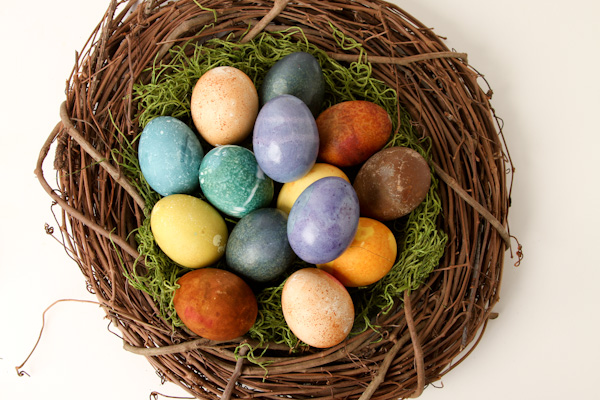 I decided to try my hand at making Easter Eggs using only natural ingredients this year. I pulled food and spices out of the cabinet and fridge and got busy trying different things to see what works and what doesn’t.
I decided to try my hand at making Easter Eggs using only natural ingredients this year. I pulled food and spices out of the cabinet and fridge and got busy trying different things to see what works and what doesn’t.
I remember my mom and grandma using red onion skins to dye eggs when I was child, but I don’t remember how they dyed the eggs using them. A little research and I had an idea of how to go about dyeing the eggs using natural ingredients.
I used the following items to dye eggs:
Coffee
Tea
Red Onion
Red Cabbage
Turmeric
Yellow Onion
Blueberry + Cranberry Juice
Blueberry
Chili Powder
Cayenne Pepper
Alan is quite the trooper. He came home and saw my little experiment going on in the kitchen and just took it in stride. These bowls took up about 75% of my counter space so nothing else would be happening in the kitchen (ie: cooking dinner) until the experiment was over. The items that you see at the far left of the image are some of the ingredients for my super tonic that I’ll be sharing with you soon.
I left the eggs in the solution for 2.5 hours, 5 hours, and 9 hours just to see what kind of colors occurred over long periods.
At 2.5 hours some of the eggs could have been considered done, but I wanted to see the results from leaving them in longer.
At five hours the red cabbage eggs are turning a beautiful color blue.
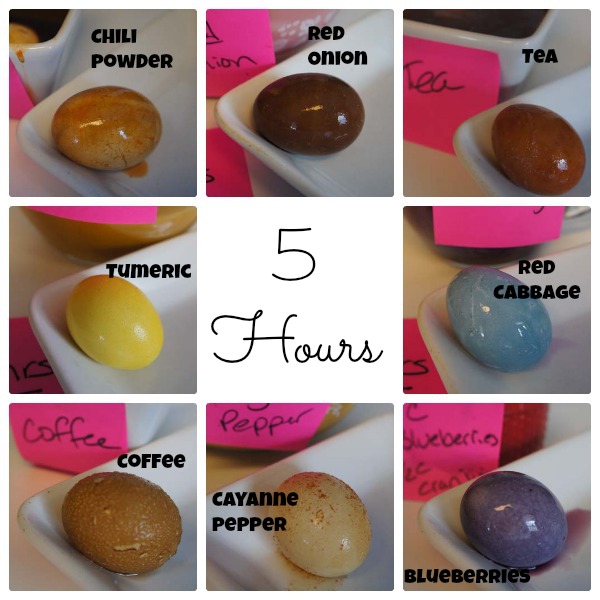
Nine hours was too long. I could have been done at 2.5, perhaps sooner, for most of the eggs and 5 hours for the turmeric and red cabbage.
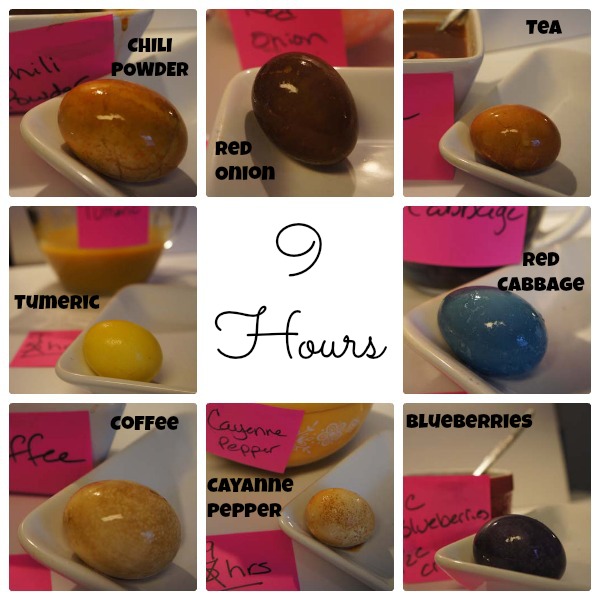
Some of the eggs could have come out of the solution right away and some others needed the full 9 hours. I’m sharing the “how to” for each egg below.
Here are the eggs after 9 hours in the liquid and air drying. The only exception is the two different blueberry eggs in the chart. The one in the upper right corner is blueberry and cranberry juice after nine hours and the eggs in the lower left is eggs just rolled in blueberry juice and removed immediately. The yellow onion was also only left in for a couple hours. I done those two sets of eggs the next day so didn’t include them in the 9 hour experiment.
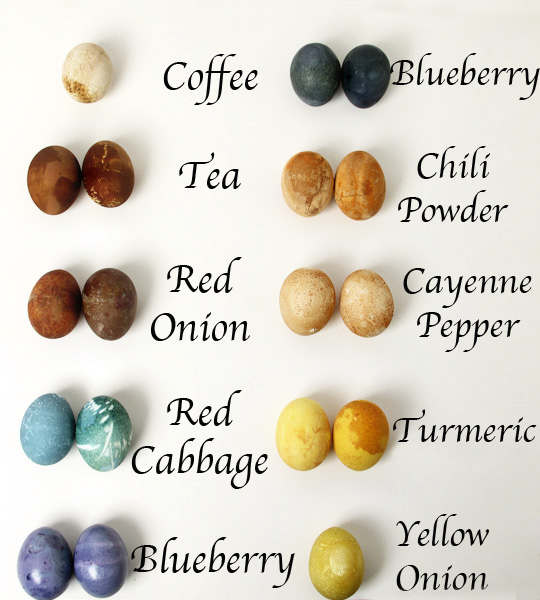
For the majority of these eggs I used the cold method. Just mix the ingredients in a non-staining bowl (ie: glass is great) and add hard boiled eggs. Let them sit until the desired color is achieved.
For the hot method I added the ingredients and raw eggs to a non-aluminum pan, brought the mixture to a boil, reduced the heat and let simmer for 15 minutes. Remove from heat and let sit until eggs achieve the desired color.
The method used is noted in the directions below.
NOTE: The eggs may take on the flavor of the coloring agent.

YELLOW ONION SKINS: 1 cup of water, room temp + dry peel from one medium yellow onion + 1/8 cup of white vinegar (cold method). This combination will color one egg. Instead of throwing dry onion skins away during the year you can save them to color Easter eggs in the Spring. (The little dash of blue you see on the left side of the egg is from a rogue blueberry that ended up in the pan.
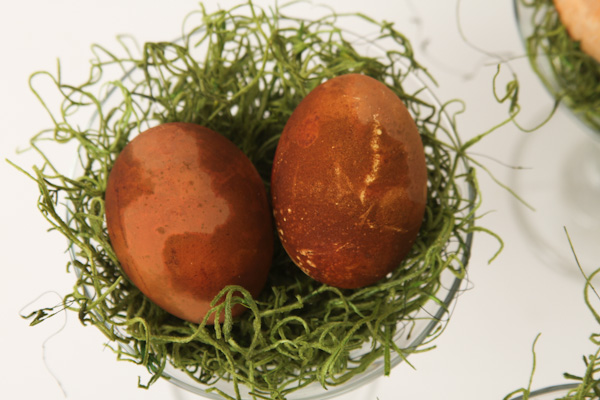
TEA: 3 tea bags+1 cup steaming hot water+1/8 cup of white vinegar (cold method). Steep the tea bags to make very strong tea. Add eggs and let sit in water until desired color is achieved.
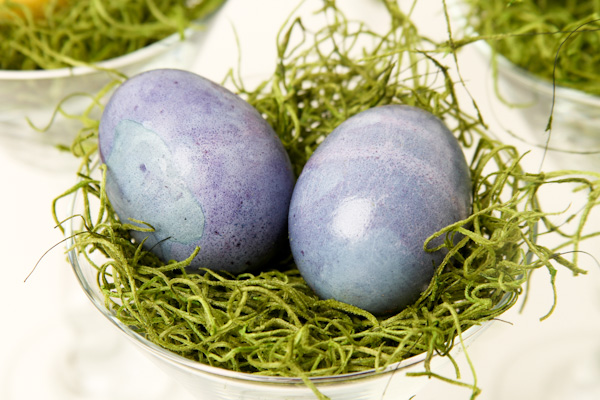
BLUEBERRIES: 1/2 cup frozen blueberries (thawed & smashed) + 2 Tablespoons white vinegar (cold method). Roll eggs until color is achieved and then remove. These took just a couple minutes to make.
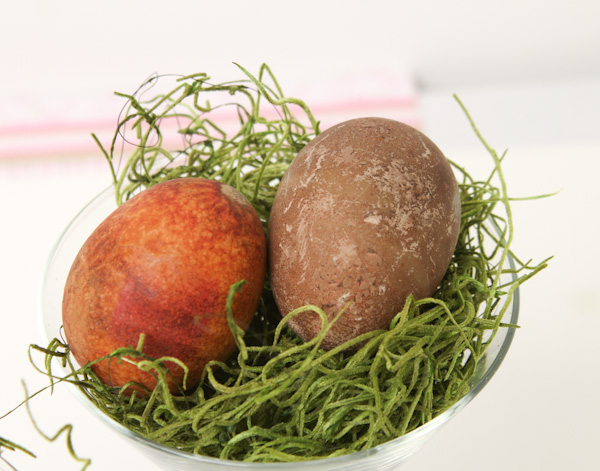
RED ONION SKINS: 1 Cup water + dry peel from 1 large red onion + 1/8 cup white vinegar (hot method). This combination colored 2 eggs. As with the yellow onion skins, red onion skins can be saved throughout the year as well.
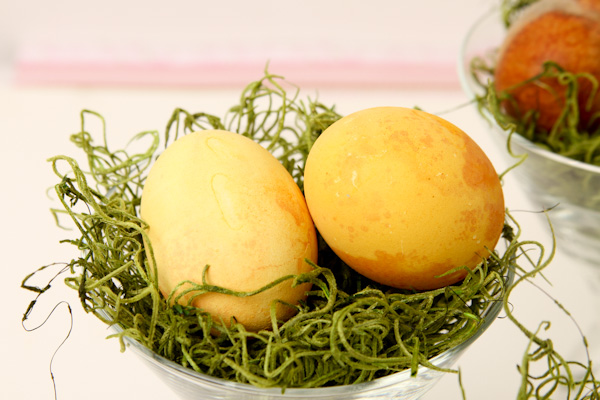
TURMERIC: 2 cups warm water+ 3 tablespoons turmeric + 1/8 cup white vinegar (cold method). This ended up being one of my favorite colors. The turmeric creates a beautiful yellow color that reminds me of spring. The darker areas are where the egg sat on undissolved turmeric.
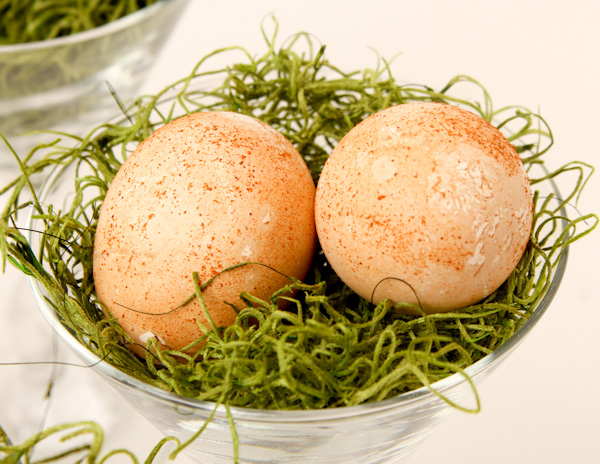
CAYENNE PEPPER: 2 cups warm water + 3 tablespoons cayenne pepper + 1/8 cup white vinegar (cold method). The speckles are created from the undissolved cayenne pepper.
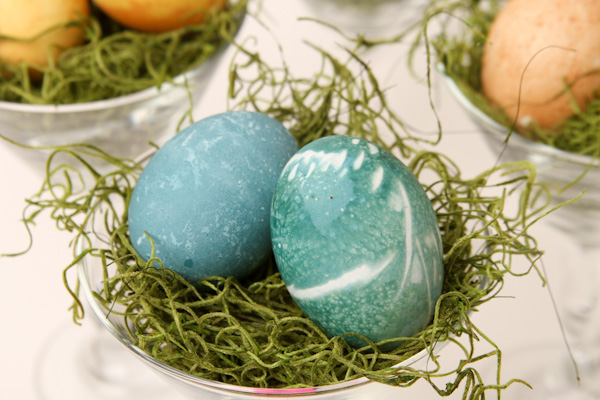
RED CABBAGE: 1/2 of red cabbage head, chopped up + 1/8 cup white vinegar + 4 eggs + enough water to cover eggs (hot method). I love, love, love this color. The egg with white speckles/lines was created by wrapping an egg in a cabbage leaf and securing with a rubber band and then adding to pan with the other ingredients.
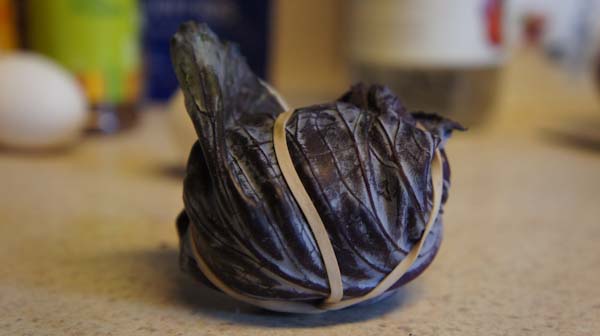
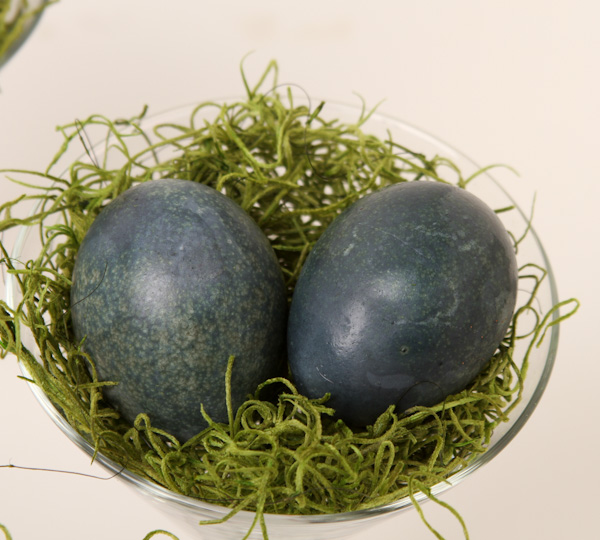
BLUEBERRY/CRANBERRY JUICE: 1 cup frozen blueberries, thawed and smashed, 1/2 cup 100% cranberry juice + 1/8 cup white vinegar (cold method). I’m not sure how much impact the cranberry juice had on the color but I needed some liquid for the eggs to sit in and I didn’t want to dilute it with water so I used some cranberry juice. 9 hours was too long, in my opinion, for these eggs. I thought they were perfect around 2.5 hours for a light spring color.
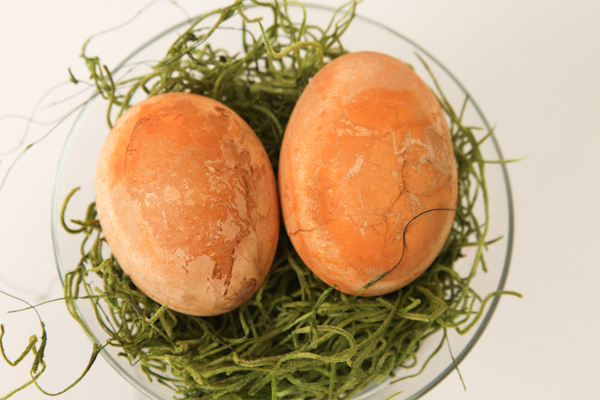
CHILI POWDER: 2 cups warm water + 3 tablespoons chili powder + 1/8 cup white vinegar (cold method). Eh, wouldn’t make these again. The color reminded me a lot of brown eggs.
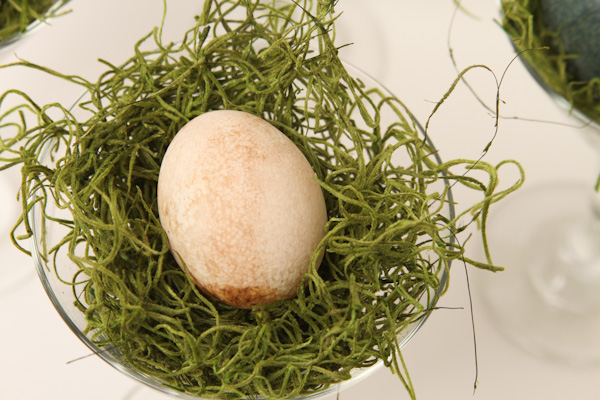
COFFEE: 1 cup of very strong brewed coffee + 1/8 cup white vinegar (cold method). This egg was a little darker, but I wiped the egg off after taking it out of the liquid and ended up with this light tan color.

I remember my mom and grandma using red onion skins to dye eggs when I was child, but I don’t remember how they dyed the eggs using them. A little research and I had an idea of how to go about dyeing the eggs using natural ingredients.
I used the following items to dye eggs:
Coffee
Tea
Red Onion
Red Cabbage
Turmeric
Yellow Onion
Blueberry + Cranberry Juice
Blueberry
Chili Powder
Cayenne Pepper
I left the eggs in the solution for 2.5 hours, 5 hours, and 9 hours just to see what kind of colors occurred over long periods.
At 2.5 hours some of the eggs could have been considered done, but I wanted to see the results from leaving them in longer.
At five hours the red cabbage eggs are turning a beautiful color blue.

Nine hours was too long. I could have been done at 2.5, perhaps sooner, for most of the eggs and 5 hours for the turmeric and red cabbage.

Some of the eggs could have come out of the solution right away and some others needed the full 9 hours. I’m sharing the “how to” for each egg below.
Here are the eggs after 9 hours in the liquid and air drying. The only exception is the two different blueberry eggs in the chart. The one in the upper right corner is blueberry and cranberry juice after nine hours and the eggs in the lower left is eggs just rolled in blueberry juice and removed immediately. The yellow onion was also only left in for a couple hours. I done those two sets of eggs the next day so didn’t include them in the 9 hour experiment.

NATURAL DYED EASTER EGGS INSTRUCTIONS
I used two different methods to make these eggs; a cold method and a hot method.For the majority of these eggs I used the cold method. Just mix the ingredients in a non-staining bowl (ie: glass is great) and add hard boiled eggs. Let them sit until the desired color is achieved.
For the hot method I added the ingredients and raw eggs to a non-aluminum pan, brought the mixture to a boil, reduced the heat and let simmer for 15 minutes. Remove from heat and let sit until eggs achieve the desired color.
The method used is noted in the directions below.
NOTE: The eggs may take on the flavor of the coloring agent.

YELLOW ONION SKINS: 1 cup of water, room temp + dry peel from one medium yellow onion + 1/8 cup of white vinegar (cold method). This combination will color one egg. Instead of throwing dry onion skins away during the year you can save them to color Easter eggs in the Spring. (The little dash of blue you see on the left side of the egg is from a rogue blueberry that ended up in the pan.

TEA: 3 tea bags+1 cup steaming hot water+1/8 cup of white vinegar (cold method). Steep the tea bags to make very strong tea. Add eggs and let sit in water until desired color is achieved.

BLUEBERRIES: 1/2 cup frozen blueberries (thawed & smashed) + 2 Tablespoons white vinegar (cold method). Roll eggs until color is achieved and then remove. These took just a couple minutes to make.

RED ONION SKINS: 1 Cup water + dry peel from 1 large red onion + 1/8 cup white vinegar (hot method). This combination colored 2 eggs. As with the yellow onion skins, red onion skins can be saved throughout the year as well.

TURMERIC: 2 cups warm water+ 3 tablespoons turmeric + 1/8 cup white vinegar (cold method). This ended up being one of my favorite colors. The turmeric creates a beautiful yellow color that reminds me of spring. The darker areas are where the egg sat on undissolved turmeric.

CAYENNE PEPPER: 2 cups warm water + 3 tablespoons cayenne pepper + 1/8 cup white vinegar (cold method). The speckles are created from the undissolved cayenne pepper.

RED CABBAGE: 1/2 of red cabbage head, chopped up + 1/8 cup white vinegar + 4 eggs + enough water to cover eggs (hot method). I love, love, love this color. The egg with white speckles/lines was created by wrapping an egg in a cabbage leaf and securing with a rubber band and then adding to pan with the other ingredients.


BLUEBERRY/CRANBERRY JUICE: 1 cup frozen blueberries, thawed and smashed, 1/2 cup 100% cranberry juice + 1/8 cup white vinegar (cold method). I’m not sure how much impact the cranberry juice had on the color but I needed some liquid for the eggs to sit in and I didn’t want to dilute it with water so I used some cranberry juice. 9 hours was too long, in my opinion, for these eggs. I thought they were perfect around 2.5 hours for a light spring color.

CHILI POWDER: 2 cups warm water + 3 tablespoons chili powder + 1/8 cup white vinegar (cold method). Eh, wouldn’t make these again. The color reminded me a lot of brown eggs.

COFFEE: 1 cup of very strong brewed coffee + 1/8 cup white vinegar (cold method). This egg was a little darker, but I wiped the egg off after taking it out of the liquid and ended up with this light tan color.
SAFETY NOTE:
Thanks to reader Charity Woods for bringing up the safety issue of consuming eggs that have sat out. I neglected to mention this in my post so please be advised of the following: “Do not eat hard boiled eggs that have been left out for more than 2 hours. Refrigerate hard boiled eggs within 2 hours 45degrees or less, eat within 1 week! Raw eggs can only be left out for 2 hours or less also. We don’t want people out there getting sick.”Monday, March 25, 2013
How to Trellis Tomatoes
I can never get those tomato cages to work for me. I tried the Topsy-Turvy one year and dumped the tomatoes all over the ground ... maybe I will try this method for staking up my tomatoes this year.
My tomatoes are only a few inches tall and still indoors, but this is the ideal time to start thinking about how to trellis them. For years I fiddled with the dinky round tomato cages sold everywhere that just fall over when faced with a large indeterminate tomato. One year I even tried tying two cages on top of one another and it still fell over.
Market Farmers don't use wussy home-gardening-type trellises. They bring out the T-Posts and plastic baling twine orstring. (This is one time you can't use natural twines like jute or cotton...they are too stretchy.) The most common technique is called the Florida Weave.
Basically, you place tall (7 foot min) T-posts at each end of your tomato row. Every two or three plants, add a stake (or another T post). You will then “weave” the twine around the T-posts and tomatoes in a basic figure-eight shape. T-posts are super sturdy and stay put once you pound them into the ground. Ideally, you can string the T-posts before the tomatoes are tall or perhaps even planted. As the tomatoes grow you can tuck the growing edge into one of the rows of string. The beauty of the Florida Weave is that even if you are late getting your trellising in place, you can still do a pretty good job pulling up the overgrown tomatoes.
Photo Credits and More Info:
http://www.specialtycrops.colostate.edu/techniques/trellis.htm#tomatoes
http://www.foogod.com/~torquill/barefoot/weave.html
http://www.organicgardening.com/learn-and-grow/cat-s-cradle-tomatoes
http://www.finegardening.com/how-to/articles/supporting-cast-for-tomatoes.aspx
Trellis like a Pro
by Sandy Swegel
Market Farmers don't use wussy home-gardening-type trellises. They bring out the T-Posts and plastic baling twine orstring. (This is one time you can't use natural twines like jute or cotton...they are too stretchy.) The most common technique is called the Florida Weave.
Basically, you place tall (7 foot min) T-posts at each end of your tomato row. Every two or three plants, add a stake (or another T post). You will then “weave” the twine around the T-posts and tomatoes in a basic figure-eight shape. T-posts are super sturdy and stay put once you pound them into the ground. Ideally, you can string the T-posts before the tomatoes are tall or perhaps even planted. As the tomatoes grow you can tuck the growing edge into one of the rows of string. The beauty of the Florida Weave is that even if you are late getting your trellising in place, you can still do a pretty good job pulling up the overgrown tomatoes.
Photo Credits and More Info:
http://www.specialtycrops.colostate.edu/techniques/trellis.htm#tomatoes
http://www.foogod.com/~torquill/barefoot/weave.html
http://www.organicgardening.com/learn-and-grow/cat-s-cradle-tomatoes
http://www.finegardening.com/how-to/articles/supporting-cast-for-tomatoes.aspx
Sunday, March 24, 2013
Alternatives to Soy: Substitutes for Soy Products
If you are like me and my husband and you are in the process of eliminating soy in your diet, this article from The Kitchn has some great suggestions for alternatives for tofu, miso, soy sauce and more.
If you're allergic to soybeans or want to reduce your consumption of soy for other reasons, foods like tofu, miso, and soy sauce are out. A soy-free diet can be even harder if you're a vegetarian or vegan. Check out this list of soy alternatives and leave your own suggestions in the comments.
 |
| Image from www.thekitchn.com |
• Edamame Substitutes: Green peas and fresh fava and lima beans are good substitutes.
• Miso Substitutes: Miso is traditionally made from fermented soybeans, but chickpea versions can be found from South River Miso Company and Miso Master, and South River also makes an adzuki bean miso. If you have the patience to wait a year, you can also go the DIY fermentation route (Sandor Katz is a good resource).
• Tofu and Tempeh Substitutes: Unfortunately there's no true substitute for these products, but depending on the dish you may be able to use ingredients like mushrooms (puffballs are especially tofu-like), chickpeas and other beans, or seitan that has made without soy sauce. Ricotta cheese, sour cream, and yogurt can sometimes work in place of silken tofu.
• Soy Milk Substitutes: Other milk alternatives like rice and almond milk tend to be much lower in protein, although many of them do have other nutritional benefits. If it's protein you're after, consider goat's milk, hemp milk (which contains 10 essential amino acids), or homemade quinoa milk.
• Soy Sauce Substitutes: Soy sauce, shoyu, tamari, and Bragg Liquid Aminos are all made from soybeans. Instead, try coconut aminos made from coconut tree sap.
• Textured Vegetable Protein (TVP) Substitutes: This soy protein is often used as a substitute for ground meats. Similar textures can be achieved by using hamburger, quinoa, or coarse bulgur.
Planting and Care for Onions
We are getting ready to plant our onions this weekend. I went to Shonnard's Nursery and bought some Walla Walla transplants, some shallot sets, and a pack of bunching onions (scallions or green onions). I went to WikiHow and found this information on how to plant and care for onions. Enjoy!
1. Research your growing zone. You can often find this online and it will determine whether you need to choose a short-day or long-day sweet onion variety. This is important, since the season in a warmer climate is very different from the season in a northern area.
If you live in the United States, you can consult the United States Department of Agriculture website. It features a hardiness zone chart that will advise you on what you can plant in your garden.
2. Decide if you want to plant your onions in seed, seedling or set form. An onion set is a small onion bulb that has already begun to grow.
If you have a shorter growing season, order sets of onions and place them in moist potting soil 2 to 3 weeks before you plant them outdoors. They will begin to sprout and grow roots.
To get a good selection of sweet onions, you may have to order them from a catalog, rather than a gardening center. They will also be more expensive.
3. Till your garden as soon as it is thawed in the spring, or harvested from the previous season in the fall. Planting happens in the fall in hotter climates, and in the spring in cooler climates.
Plant onions in the fall, if you live in milder plains climates. Plant onions in the spring if you live in mountain climates that see a lot of snow.
4. Choose a place in your garden that has well-drained soil. This ensures that the onion does not sit in still water and rot or develop mold.
5. Add some compost to your soil before you plant. Work it down into the soil using garden tools or a tiller. Onions like a good amount of organic matter in the soil.
6. Plant the onions in the soil differently, depending if you are using seeds, seedlings or sets.
If you are growing sweet onions from seeds, plant each seed 3/8 of an inch (1 cm) deep and 1/2 inch (1.3 cm) apart. When you plant rows, make sure they are 15 inches (38 cm) apart. Once they become seedlings, you will want to thin your onions until they are 3 inches (7.6 cm) apart. Thinning means to pull up seedlings that are too close together to make sure they are not competing for the same growing space and nutrients.
If you are growing sweet onions from seedlings, then plant them 1 inch (2.54 cm) into the soil, about 4 inches (10.2 cm) apart. Rows should remain separated by 15 inches (38 cm).
If you are planting sweet onions from sets, plant them 3 inches (7.6 cm) apart, and rows at 15 inches (38 cm) apart. Plant them shallowly, with the roots into the ground, and the bulb only about 1/4 inch (0.6 cm) into the ground. Pinch dirt around the onion so it stays supported. Place compost, mulch or finely cut hay around each onion to give it further support.
7. Water the onions every 5 to 7 days. They will need more water in the beginning and less at the end of the growing season. Depending upon the amount of rain you get, you may not need to hand water them very often.
8. Weed your onion bed often by hand and with a hoe. Weeds compete with the onion for nutrients, so you want to keep them weed free.
9. Wait 3 months to harvest your onions, if they started from sets. If you planted seeds or seedlings, they will take a few weeks to a month longer, depending upon the warmth of your growing season.
10. Harvest when the tops of the onion plant turn from green to yellow and the stalks fall over.
Many commercial farmers break the tops of the plants when they start to yellow, to stop them from ripening and start them curing. Many small-scale gardeners believe that this causes smaller bulbs that do not store for very long.
Harvest before the plant begins to flower. If you have flowering onion plants, remove the onion from the ground immediately and use it. It will not store like your other plants.
11. Pull the mature onion bulbs out of the ground in the morning.
12. Lay them on top of the soil and allow them to air dry until late afternoon. If the sun is especially hot, they should be taken out of the sun and dried outside in the shade.
13. Tie or braid the onions together in small bunches.
14. Hang them in a well-ventilated area for 2 to 3 weeks.
15. Cut the bulb tops to be 1 inch (2.54 cm) long.
16. Store them in a cool, dry place that is well-ventilated. Store sweet onions for up to 2 months. Because of their higher water content, they do not last as long as other dry bulbs.
Sweet onions, a dry bulb root vegetable, are often referred to by their regional names, such as Vidalia, Sweet Spanish, Bermuda, Maui Sweet and Walla Walla. Region is important in deciding their flavor, as they are chosen and planted according to the amount of daylight in the growing region. For example, short-day varieties only require 12 to 14 hours of light per day, while long-day varieties require at least 14 to 16 hours of light daily. Sweet onions require a good amount of attention, and they are planted differently than other dry bulb or green onions. This article will tell you how to grow sweet onions.
Steps:
1. Research your growing zone. You can often find this online and it will determine whether you need to choose a short-day or long-day sweet onion variety. This is important, since the season in a warmer climate is very different from the season in a northern area.
If you live in the United States, you can consult the United States Department of Agriculture website. It features a hardiness zone chart that will advise you on what you can plant in your garden.
2. Decide if you want to plant your onions in seed, seedling or set form. An onion set is a small onion bulb that has already begun to grow.
If you have a shorter growing season, order sets of onions and place them in moist potting soil 2 to 3 weeks before you plant them outdoors. They will begin to sprout and grow roots.
To get a good selection of sweet onions, you may have to order them from a catalog, rather than a gardening center. They will also be more expensive.
3. Till your garden as soon as it is thawed in the spring, or harvested from the previous season in the fall. Planting happens in the fall in hotter climates, and in the spring in cooler climates.
Plant onions in the fall, if you live in milder plains climates. Plant onions in the spring if you live in mountain climates that see a lot of snow.
4. Choose a place in your garden that has well-drained soil. This ensures that the onion does not sit in still water and rot or develop mold.
5. Add some compost to your soil before you plant. Work it down into the soil using garden tools or a tiller. Onions like a good amount of organic matter in the soil.
6. Plant the onions in the soil differently, depending if you are using seeds, seedlings or sets.
If you are growing sweet onions from seeds, plant each seed 3/8 of an inch (1 cm) deep and 1/2 inch (1.3 cm) apart. When you plant rows, make sure they are 15 inches (38 cm) apart. Once they become seedlings, you will want to thin your onions until they are 3 inches (7.6 cm) apart. Thinning means to pull up seedlings that are too close together to make sure they are not competing for the same growing space and nutrients.
If you are growing sweet onions from seedlings, then plant them 1 inch (2.54 cm) into the soil, about 4 inches (10.2 cm) apart. Rows should remain separated by 15 inches (38 cm).
If you are planting sweet onions from sets, plant them 3 inches (7.6 cm) apart, and rows at 15 inches (38 cm) apart. Plant them shallowly, with the roots into the ground, and the bulb only about 1/4 inch (0.6 cm) into the ground. Pinch dirt around the onion so it stays supported. Place compost, mulch or finely cut hay around each onion to give it further support.
7. Water the onions every 5 to 7 days. They will need more water in the beginning and less at the end of the growing season. Depending upon the amount of rain you get, you may not need to hand water them very often.
8. Weed your onion bed often by hand and with a hoe. Weeds compete with the onion for nutrients, so you want to keep them weed free.
9. Wait 3 months to harvest your onions, if they started from sets. If you planted seeds or seedlings, they will take a few weeks to a month longer, depending upon the warmth of your growing season.
10. Harvest when the tops of the onion plant turn from green to yellow and the stalks fall over.
Many commercial farmers break the tops of the plants when they start to yellow, to stop them from ripening and start them curing. Many small-scale gardeners believe that this causes smaller bulbs that do not store for very long.
Harvest before the plant begins to flower. If you have flowering onion plants, remove the onion from the ground immediately and use it. It will not store like your other plants.
11. Pull the mature onion bulbs out of the ground in the morning.
12. Lay them on top of the soil and allow them to air dry until late afternoon. If the sun is especially hot, they should be taken out of the sun and dried outside in the shade.
13. Tie or braid the onions together in small bunches.
14. Hang them in a well-ventilated area for 2 to 3 weeks.
15. Cut the bulb tops to be 1 inch (2.54 cm) long.
16. Store them in a cool, dry place that is well-ventilated. Store sweet onions for up to 2 months. Because of their higher water content, they do not last as long as other dry bulbs.
This might be a good kit to put together and toss into the back of your car in case of emergency from Prepping to Survive.
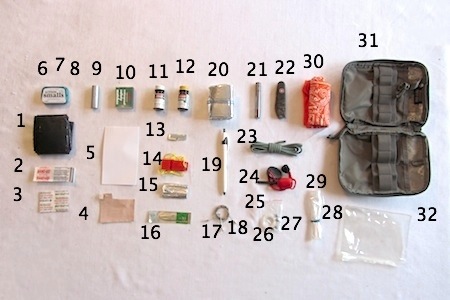
My wallet isn’t thick and it’s certainly not lined with credit cards, but I do carry something with me every day that is much more important than any piece of plastic from a financial institution. It’s my Every Day Carry (EDC) Survival Kit.
I put this kit together many years ago with one thought in mind: if I were to get stranded on the side of the road over night, if I were to get lost in the woods for a few days, if I were to not be able to make it home for any reason and had to spend the night without food or pre-made shelter, what would I want to have with me to make my stay more pleasant.
As I assembled the items, I wanted the kit to be lightweight and easy to carry. A heavy or cumbersome kit will most often get left behind and that defeats the purpose.
I started with a small Altoids tin but I quickly found some deficiencies with that container. Now I use a Maxpedition EDC Pocket Organizer. It works well despite being a little larger than I’d like.
Here’s what my EDC includes:

In prior posts, I’ve written about the multiple uses or purposes of many of these items. For example, the yard bag can be used as make-shift rain gear, a water catch, a shelter covering, an insulated jacket, or a distress signal. Likewise a handkerchief or bandana has a bunch of uses for the survivor. You can find these posts in the Survival Kit category. I’ll continue to post about the other items.
I typically carry this kit in a backpack with other supplies including my first aid kit, some homemade MREs, a rain coat, a water bottle, metal cup, fixed-blade knife, etc. So, although this kit is designed to be self-contained, I do typically have some other items with me as well. I’ll post that list another time.
What am I missing? What do you carry?
Making a 32-Piece Every Day Carry (EDC) Survival Kit
February 11, 2013
Survival Kits

I put this kit together many years ago with one thought in mind: if I were to get stranded on the side of the road over night, if I were to get lost in the woods for a few days, if I were to not be able to make it home for any reason and had to spend the night without food or pre-made shelter, what would I want to have with me to make my stay more pleasant.
As I assembled the items, I wanted the kit to be lightweight and easy to carry. A heavy or cumbersome kit will most often get left behind and that defeats the purpose.
I started with a small Altoids tin but I quickly found some deficiencies with that container. Now I use a Maxpedition EDC Pocket Organizer. It works well despite being a little larger than I’d like.
Here’s what my EDC includes:
- Contractor yard bag
- 5 self-adhesive bandages
- 4 self-adhesive butterfly bandages
- Moleskin
- Index cards
- Cotton balls (inside the Altoids tin)
- Ibuprofen (inside the Altoids tin)
- Altoids Mini Tin
- Duct tape
- Waterproof matches
- Iodine tablets
- Iodine tablet neutralizer
- P-38 can opener
- Whistle
- Aluminum foil
- Sterile surgical blade
- Safety pins
- Snare wire
- Pen
- Emergency Thermal blanket
- Mag Lite Solitaire flashlight
- Swiss Army knife
- 10′ of paracord
- Firesteel
- Small fish hooks
- Split-shot fishing sinkers
- 50 feet of fishing line
- Rubber band (around the plastic bag)
- Resealable plastic bag
- Bandana
- Maxpedition EDC Pocket Organizer
- Resealable dry pouch

In prior posts, I’ve written about the multiple uses or purposes of many of these items. For example, the yard bag can be used as make-shift rain gear, a water catch, a shelter covering, an insulated jacket, or a distress signal. Likewise a handkerchief or bandana has a bunch of uses for the survivor. You can find these posts in the Survival Kit category. I’ll continue to post about the other items.
I typically carry this kit in a backpack with other supplies including my first aid kit, some homemade MREs, a rain coat, a water bottle, metal cup, fixed-blade knife, etc. So, although this kit is designed to be self-contained, I do typically have some other items with me as well. I’ll post that list another time.
What am I missing? What do you carry?
Saturday, March 23, 2013
Green Onion Benefits and Growing Tips
I just bought my Walla Walla sweet onion sets, some shallots (which were $6.99/lb at Market of Choice so I decided that I would grow my own), and green onions. I am all ready to plant them, but I thought I better figure out HOW!!
I use a lot of shallots or green onions in my cooking for a little flavor and color, but I never realized they were so good for me. Here is a little poster that explains some of their benefits.
Green Onions have an almost unlimited amount of uses and are very easy to grow. Green onions can be grown from seed or as sets. I love green onions in soups, salads, on top of a nice steak, used as a baked potato topping, and many other ways. Green onions are also referred to as bunching onions, and have a milder onion taste than storage onions.
They are actually immature onions that are harvested before the bulb matures. The green onion features a dark green stem (also called scallions) and a white bulb with roots. Both parts of the onion are edible. There are several different cultivars of green onion including, 'Evergreen Long White', 'Parade', and 'Red Baron' to name a few.
Plant onion seed as soon as the soil can be worked in the spring. Onion seeds germinate in a wide range of soil temperature, between 65° F and 86° F.
Sow and cover seed with ½” of soil and keep moist. Seeds can be started indoors 6-8 weeks prior to planting. They can be set in the garden about 1-1½” apart. To plant onions sets, simply press sets into the soil about 2″ apart.
Onions benefit from full sun, a soil pH of 6.0-7.5 and a well drained soil with plenty of premium compost or well rotted manure added. Feed with a complete balanced fertilizer during the growing season.
Green onions generally need about one inch of water per week. If green onions are grown in rows, or raised beds, soaker hoses can be used for irrigation. It’s also a good idea to mulch around the plants to conserve soil moisture and suppress weeds.
The soil should be moist, but not soggy. A great way to check to see if your green onions need watering is the finger test. Simply stick your finger in the soil down to the second knuckle near the green onion plan. If the soil feels moist there is no need to water. If the soil feels dry go ahead and water well. Repeat the finger test once a week depending on how much rainfall you have received.
Green onions can also be grown successfully in containers. Soil in containers can dry out quickly during very hot summer temperatures, so you may need to water them up to three times per day if rainfall amounts are inadequate.
Allowing the soil to dry out too much can cause the onion bulbs to also dry out.
Also, make sure the container has good drainage holes. You want to avoid soggy soil in containers, too. Getting the watering amounts down right may take some practice, but it’s not too difficult.
To use as dried bulbs, wait until the green tops have withered and browned, then stop watering. Most green onions are ready to harvest between 70-90 days.
When you are slicing or preparing a green onion, leave about 1″ above the root. This section can be re-planted into the soil. Place the root section about 1″ deep in the soil, root side down, and lightly cover the top with soil.
The root section will then re-sprout the green tops within a couple weeks. This process can be repeated several times with the same root section. A great way to “recycle” your green onions!
I use a lot of shallots or green onions in my cooking for a little flavor and color, but I never realized they were so good for me. Here is a little poster that explains some of their benefits.
They are actually immature onions that are harvested before the bulb matures. The green onion features a dark green stem (also called scallions) and a white bulb with roots. Both parts of the onion are edible. There are several different cultivars of green onion including, 'Evergreen Long White', 'Parade', and 'Red Baron' to name a few.
Planting Green Onions
 |
| Image from www.veggiegardner.com |
Sow and cover seed with ½” of soil and keep moist. Seeds can be started indoors 6-8 weeks prior to planting. They can be set in the garden about 1-1½” apart. To plant onions sets, simply press sets into the soil about 2″ apart.
Onions benefit from full sun, a soil pH of 6.0-7.5 and a well drained soil with plenty of premium compost or well rotted manure added. Feed with a complete balanced fertilizer during the growing season.
Maintaining Green Onions
Once your green onions have sprouted become well established, they are pretty easy to maintain.Green onions generally need about one inch of water per week. If green onions are grown in rows, or raised beds, soaker hoses can be used for irrigation. It’s also a good idea to mulch around the plants to conserve soil moisture and suppress weeds.
The soil should be moist, but not soggy. A great way to check to see if your green onions need watering is the finger test. Simply stick your finger in the soil down to the second knuckle near the green onion plan. If the soil feels moist there is no need to water. If the soil feels dry go ahead and water well. Repeat the finger test once a week depending on how much rainfall you have received.
Green onions can also be grown successfully in containers. Soil in containers can dry out quickly during very hot summer temperatures, so you may need to water them up to three times per day if rainfall amounts are inadequate.
Allowing the soil to dry out too much can cause the onion bulbs to also dry out.
Also, make sure the container has good drainage holes. You want to avoid soggy soil in containers, too. Getting the watering amounts down right may take some practice, but it’s not too difficult.
Harvesting Green Onions
Green onions are best picked when they are young and tender. Dig or pull them when the tops reach between 6-8″ tall and the bulb have begun to swell.To use as dried bulbs, wait until the green tops have withered and browned, then stop watering. Most green onions are ready to harvest between 70-90 days.
When you are slicing or preparing a green onion, leave about 1″ above the root. This section can be re-planted into the soil. Place the root section about 1″ deep in the soil, root side down, and lightly cover the top with soil.
The root section will then re-sprout the green tops within a couple weeks. This process can be repeated several times with the same root section. A great way to “recycle” your green onions!
Pests & Diseases of Green Onions
Pests and diseases are rare for the home grown green onion, but they can become susceptible to maggots, thrips, and soilborne diseases. Use crop rotation to avoid these issues.Friday, March 22, 2013
Medicine Cabinet inYour Kitchen
Homemade Antiseptic Mouthwash
 |
| All images from the Frugally Sustainable Blog |
Here is another great article from the Frugally Sustainable Blog.
By now you all should know that I love to make my own natural health, home, and beauty products. I love them because they work and I love them because they’re frugal. So when I was using my fancy-pants “eco friendly, 100% natural” mouthwash the other day, I thought to myself, “I think I could make this and save myself some money!”
Benefits of Using Homemade Mouthwash
Good oral care is vital to our health and vice versa. Health and diet have even been know to heal cavities! Rinsing out the mouth with a cleansing mouthwash is a large part of good oral hygiene. And there are many benefits to making your own:
Variety of Homemade Mouthwash Recipes
There are a variety of different recipes to meet the needs of every individual. Here are just a few:
Basic Mouthwash: 1 cup water, 1 teaspoon baking soda, and 3 drops peppermint essential oils. Mix all ingredients in a glass jar and shake well. Swish in mouth, then spit out. Store on bathroom counter.
Old-Fashioned Disinfectant Mouthwash: 1 cup water and 2 tablespoons apple cider vinegar. Combine ingredients and store in a glass jar. Shake well prior to use. Swish mixture in mouth, then spit out. Will keep indefinitely on the counter.
Hydrogen Peroxide Mouthwash: 1 part hydrogen peroxide mixed with 1 part water. Swish mouthwash in mouth, then spit out. Mix enough for single use and discard extra solution.
Lemon Whitening Mouthwash: Not really a mouthwash, but you can rub a piece of lemon on stained teeth for a whitening effect.
Herbal Mouthwash: Create an herbal infusion by steeping 2 cups of boiling water, 1/2 ounce of whole cloves, 1 ounce of Oregon grape root, and 1 ounce of rosemary in a pint-sized glass mason jar, overnight. In the morning strain the infusion using a piece of cheesecloth. Swish in mouth, the spit out. Store in a glass jar in the refrigerator. Will keep for 1 week.
Simple Essential Oil Mouthwash: To 1 cup of water add 20 drops of either cinnamon, clove, wintergreen, or tea tree oil. Combine all ingredients in a glass jar. Shake well prior to each use in order to distribute the essential oils. Will keep on the bathroom counter indefinitely.
Antiseptic Homemade Mouthwash
Gather the ingredients:
-5 ounces Rum or Vodka
-4 ounces water
-1/2 ounce vegetable glycerin
-1/2 ounce powdered myrrh gum
-5 drops essential oils of cinnamon
-5 drops essential oils of clove
Directions:
Combine all ingredients in a pint-sized glass mason jar.
Shake well to blend.
To use:
I do not recommend that you use this mouthwash daily — due to the alcohol content of this mixture, it can have a drying effect. Use of this solution may be better limited to times when a more antiseptic oral cleanse is desired. Shake well prior to use. Swish in mouth, then spit out. Will store in glass jar on bathroom counter indefinitely.
Notes
Myrrh gum has broad-spectrum antiseptic properties. It is also well known as an anti-inflammatory — excellent for use in treatment of oral ailments…namely gum disease.
Cinnamon contains many antimicrobial properties as well. It also functions as a natural preservative.
Essential oils of Clove can be used to heal and prevent cavities. It relieves the pain of a toothache. And it can also act to decrease oral infections because of its antiseptic properties.
Rum and Vodka kill bacteria and freshen breath.
Most of the ingredients can be found over-the-counter at a pharmacy. You can purchase powdered myrrh gum and the essential oils from Mountain Rose Herbs or The Bulk Herb Store.
What does your natural oral care routine look like? Please share it with us.
Please note: These are my own opinions derived from my own research. The statements made here have not been approved by the Food and Drug Administration or the American Dental Association. They are not intended to diagnose, treat or cure or prevent any disease.
Thursday, March 21, 2013
Homemade Mosquito Repellant
 |
| Image from SurvivingTheStore.com |
Combine in a 16 oz bottle:
15 drops lavender oil [http://amzn.to/WOhOP8]
3-4 Tbsp of vanilla extract
10 drops of citronella oil [http://amzn.to/ZOLfyc]
1/4 Cup lemon juice.
15 drops lavender oil [http://amzn.to/WOhOP8]
3-4 Tbsp of vanilla extract
10 drops of citronella oil [http://amzn.to/ZOLfyc]
1/4 Cup lemon juice.
Fill bottle with water.
Shake and it's ready to use.
Spray on yourself.
(You can also use 10 drops of lemon eucalyptus oil instead of citronella oil [http://amzn.to/ZfYPbx])
Make some extra to gift to your neighbors, family & friends. Share this on your wall so you'll have it handy when it's needed.
Note: If you don't already have the oils mentioned above, the links provided are available for you to order them online.
P.S. I actually learned this little bit of trivia in a Trivia Game. Mosquitos are attracted to people who eat bananas. Guess what is off my food list in the summer!!!
Meals in Jars plus Recipes
I saw this article on the Frugally Sustainable FB page. Even though she is concerned about food prices and shortages, I think these ideas would be terrific for camping trips and quicky dinners, too!
Meals in Jars
September 27, 2011 By Andrea
When I see news headlines like these…
U.S. Drought Driving Up Already Rising Food Prices While Economy Collapses! Get Prepared!
Drought means beef prices could rise
Multi-Billion Dollar Drought to Drive Beef Prices Up
…my first reaction is to freak out! It’s natural to experience feelings of fear and/or anxiety when reading news stories like this, right? But why, why would I waste one second of my life worrying about something I have no control over? You know what eases my fear: knowledge, preparedness, and a community of people that I trust.
About six months ago we began storing food. Buckets and buckets of organic beans, rice, quinoa, millet, oatmeal, popcorn, etc. now fill the once empty spaces of our closets. Given the access to water, we would be able to feed our immediate family and my parents (maybe even help out the neighbors) for about half a year. However, my thoughts lately are turning toward the possibility of using this food in the event prices of commodities were to increase, even more than they already have.

I’ve also been trying to organize what we do have and make it more practical for use. Today I began working on “meals in jars.” By combining beans, grains, dehydrated veggies/fruit from the garden, and seasonings I am attempting to ensure that we will have a supply of tasty and nutritious meals in the case of an emergency. Not to mention, it’s been a fun activity for the kids and I. It’s like canning beans and grains, but instead of using the pressure cooker all we do is place an oxygen absorber in the jar (smile).

There are thousands of different recipes you could follow when creating your meals in jars. Just remember to combine items that take approximately the same amount of time to cook. For example, do not intermix pasta with navy beans. The pasta will cook much quicker than the beans.
For an abundance of recipes to use as a foundation for your meals in jars look on this forum. Below I have also provided you with a few of the recipes we put together today.
Apple Cinnamon Oatmeal (1 pint jar)
-1 cup oatmeal
-1 tsp cinnamon
-1/4 cup sliced almonds
-1/4 cup dehydrated apples
*2 cups water necessary to reconsitute
Vegetable Millet (1 pint jar)
-1 cup millet
-1/4 cup dehydrated mixed veggies
-1/4 cup dried parsley
-1 tsp dehydrated minced garlic
-1 tsp salt
*3 cups of water necessary to reconsitute
Quinoa and Lentil Soup (1 quart jar)
-1 ½ cup quinoa
-1 ½ cup red lentils
-1/2 cup dehydrated veggies
-1/4 cup dehydrated onion
-1 tsp minced garlic
-1 tsp salt
-2 bay leaves
*5 cups of water necessary to reconsitute
Lemon Dill Rice (1 pint jar)
-1 cup rice
-1/2 tsp dried dill
-1 ½ tsp dehydrated lemon peel
-1/2 tsp salt
*2 cups of water necessary to reconsitute
For each recipe, layer ingredients in order as listed. Use the size jar as indicated. Place an oxygen absorber on top and then close lid. Store jars in a safe place. Keep off shelves.
Storage Tips
-The best way to store beans, grains, and dehydrated veggies/fruit is in a sealed mylar bag along with oxygen absorbers. The individual meals could then be stored in a 5-gallon bucket. Lightweight, takes up less space, it’s just a much better option. So, I’ll continue saving for the supplies required for this system of storage.
I recommend purchasing mylar bags, oxygen absorbers, and heat sealers from the fine folks over at Preparing Wisely and SorbentSystems.com who sell Made-in-America products.
U.S. Drought Driving Up Already Rising Food Prices While Economy Collapses! Get Prepared!
Drought means beef prices could rise
Multi-Billion Dollar Drought to Drive Beef Prices Up
…my first reaction is to freak out! It’s natural to experience feelings of fear and/or anxiety when reading news stories like this, right? But why, why would I waste one second of my life worrying about something I have no control over? You know what eases my fear: knowledge, preparedness, and a community of people that I trust.
About six months ago we began storing food. Buckets and buckets of organic beans, rice, quinoa, millet, oatmeal, popcorn, etc. now fill the once empty spaces of our closets. Given the access to water, we would be able to feed our immediate family and my parents (maybe even help out the neighbors) for about half a year. However, my thoughts lately are turning toward the possibility of using this food in the event prices of commodities were to increase, even more than they already have.

I’ve also been trying to organize what we do have and make it more practical for use. Today I began working on “meals in jars.” By combining beans, grains, dehydrated veggies/fruit from the garden, and seasonings I am attempting to ensure that we will have a supply of tasty and nutritious meals in the case of an emergency. Not to mention, it’s been a fun activity for the kids and I. It’s like canning beans and grains, but instead of using the pressure cooker all we do is place an oxygen absorber in the jar (smile).

There are thousands of different recipes you could follow when creating your meals in jars. Just remember to combine items that take approximately the same amount of time to cook. For example, do not intermix pasta with navy beans. The pasta will cook much quicker than the beans.
For an abundance of recipes to use as a foundation for your meals in jars look on this forum. Below I have also provided you with a few of the recipes we put together today.
Apple Cinnamon Oatmeal (1 pint jar)
-1 cup oatmeal
-1 tsp cinnamon
-1/4 cup sliced almonds
-1/4 cup dehydrated apples
*2 cups water necessary to reconsitute
Vegetable Millet (1 pint jar)
-1 cup millet
-1/4 cup dehydrated mixed veggies
-1/4 cup dried parsley
-1 tsp dehydrated minced garlic
-1 tsp salt
*3 cups of water necessary to reconsitute
Quinoa and Lentil Soup (1 quart jar)
-1 ½ cup quinoa
-1 ½ cup red lentils
-1/2 cup dehydrated veggies
-1/4 cup dehydrated onion
-1 tsp minced garlic
-1 tsp salt
-2 bay leaves
*5 cups of water necessary to reconsitute
Lemon Dill Rice (1 pint jar)
-1 cup rice
-1/2 tsp dried dill
-1 ½ tsp dehydrated lemon peel
-1/2 tsp salt
*2 cups of water necessary to reconsitute
For each recipe, layer ingredients in order as listed. Use the size jar as indicated. Place an oxygen absorber on top and then close lid. Store jars in a safe place. Keep off shelves.
Storage Tips
-The best way to store beans, grains, and dehydrated veggies/fruit is in a sealed mylar bag along with oxygen absorbers. The individual meals could then be stored in a 5-gallon bucket. Lightweight, takes up less space, it’s just a much better option. So, I’ll continue saving for the supplies required for this system of storage.
I recommend purchasing mylar bags, oxygen absorbers, and heat sealers from the fine folks over at Preparing Wisely and SorbentSystems.com who sell Made-in-America products.
The Ant Solution
 |
| Image from Wesley Jueckstock |
Caution: Because boric acid is not pet friendly, the best container would be a small jar or plastic container with a lid in which you have punched some holes.
Ingredients:
1 cup sugar
3 tablespoons boric acid
3 cups warm water
Directions:
1. Mix the sugar and boric acid well.
2. Add the warm water slowly, mixing all the while so it won't be too lumpy.
3. Store in a jar until ready to use.
4. When ready to use, put cotton into the top of a jar lid to fill it and then saturate the cotton to the top.
5. Place it in the location where it is needed.
6. Note: This solution will keep for a long while. A good technique is to drip a drop or two over the edge of the lid to rest on the counter so the ants will find the solution sooner. It sometimes takes a little while for them to find it, but find it they will. When they do, do not disturb them as they drink. They will hang over the edge of the lid and drink for a while and then take it back to the nest killing the colony. Almost overnight they will be gone.
Tuesday, March 19, 2013
The Importance of Eating Spinach plus Recipe
I HATE SPINACH!!! ... or at least I thought I did. What I hated was cooked spinach ... all stinky and slimey ... ewwwww!!
My latest discovery is that I DO like spinach ... as long as it is RAW!! The following poster from the Healthy Food web site tells us how good spinach is for us! I know, people have always said that, but this is the first time I have really eaten spinach so I am paying attention this time.
Here is a great summer salad using spinach and strawberries ... who knew they made such a great combination. This recipe comes from the Mother Nature Network.
Directions
Serves 4
My latest discovery is that I DO like spinach ... as long as it is RAW!! The following poster from the Healthy Food web site tells us how good spinach is for us! I know, people have always said that, but this is the first time I have really eaten spinach so I am paying attention this time.
Here is a great summer salad using spinach and strawberries ... who knew they made such a great combination. This recipe comes from the Mother Nature Network.
Strawberry Spinach Summer Salad
Ingredients
- 2 tablespoons balsamic vinegar
- 2 tablespoons olive oil
- 1/3 cup sliced almonds, toasted
- 1 bundle fresh spinach
- 1 cup strawberries, thinly sliced
- 4 tablespoons feta cheese, crumbled
Time estimates
Prep time: 10 minutes
Total time: 20 minutes
Directions
- Rinse veggies thoroughly.
- Combine vinegar and oil in small jar. Close lid and shake well.
- Over medium-high heat add dab of oil to saucepan. After one minute add almonds. Stir for five or six minutes or until light brown.
- Combine all ingredients in large bowl. Add feta. Toss gently and serve.
Subscribe to:
Posts (Atom)

